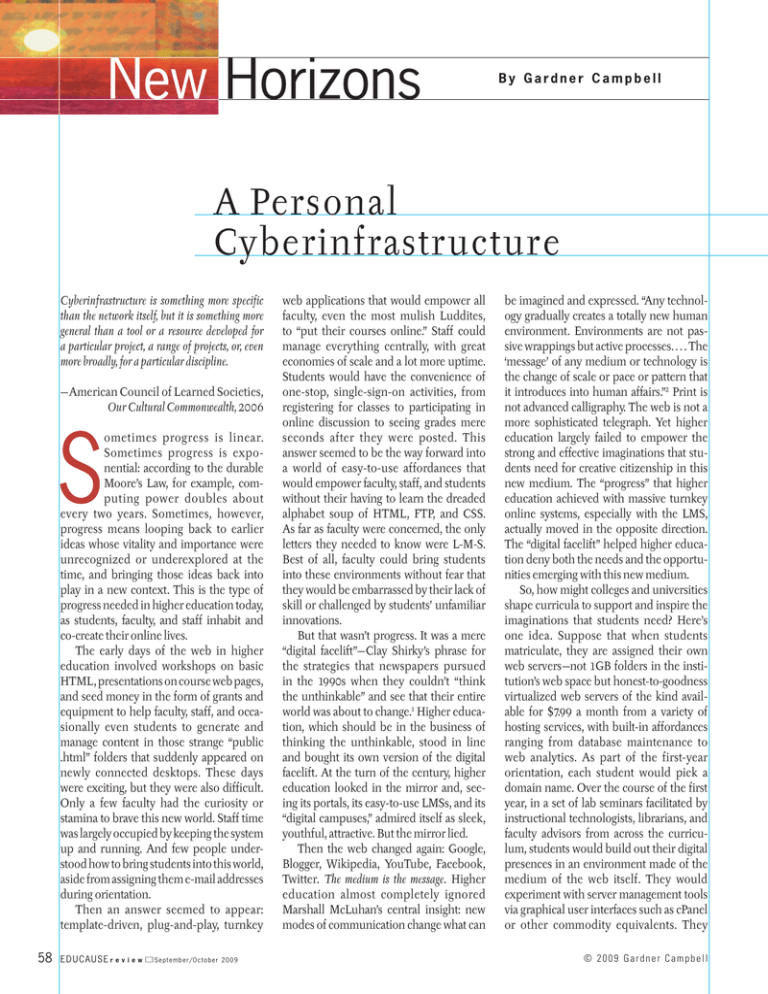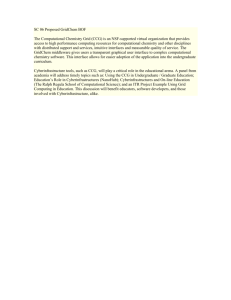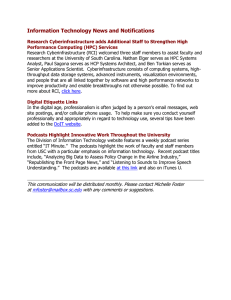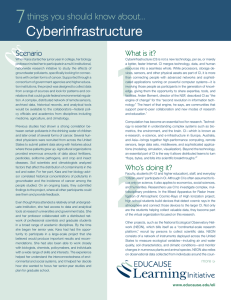A Personal Cyberinfrastructure
advertisement

New Horizons By Gardner Campbell A Personal Cyberinfrastructure Cyberinfrastructure is something more specific than the network itself, but it is something more general than a tool or a resource developed for a particular project, a range of projects, or, even more broadly, for a particular discipline. —American Council of Learned Societies, Our Cultural Commonwealth, 2006 S ometimes progress is linear. Sometimes progress is exponential: according to the durable Moore’s Law, for example, computing power doubles about every two years. Sometimes, however, progress means looping back to earlier ideas whose vitality and importance were unrecognized or underexplored at the time, and bringing those ideas back into play in a new context. This is the type of progress needed in higher education today, as students, faculty, and staff inhabit and co-create their online lives. The early days of the web in higher education involved workshops on basic HTML, presentations on course web pages, and seed money in the form of grants and equipment to help faculty, staff, and occasionally even students to generate and manage content in those strange “public .html” folders that suddenly appeared on newly connected desktops. These days were exciting, but they were also difficult. Only a few faculty had the curiosity or stamina to brave this new world. Staff time was largely occupied by keeping the system up and running. And few people understood how to bring students into this world, aside from assigning them e-mail addresses during orientation. Then an answer seemed to appear: ­template-driven, plug-and-play, turnkey 58 Educause r e v i e w September/October 2009 web applications that would empower all faculty, even the most mulish Luddites, to “put their courses online.” Staff could manage everything centrally, with great economies of scale and a lot more uptime. Students would have the convenience of one-stop, single-sign-on activities, from registering for classes to participating in online discussion to seeing grades mere seconds after they were posted. This answer seemed to be the way forward into a world of easy-to-use affordances that would empower faculty, staff, and students without their having to learn the dreaded alphabet soup of HTML, FTP, and CSS. As far as faculty were concerned, the only letters they needed to know were L-M-S. Best of all, faculty could bring students into these environments without fear that they would be embarrassed by their lack of skill or challenged by students’ unfamiliar innovations. But that wasn’t progress. It was a mere “digital facelift”—Clay Shirky’s phrase for the strategies that newspapers pursued in the 1990s when they couldn’t “think the unthinkable” and see that their entire world was about to change.1 Higher education, which should be in the business of thinking the unthinkable, stood in line and bought its own version of the digital facelift. At the turn of the century, higher education looked in the mirror and, seeing its portals, its easy-to-use LMSs, and its “digital campuses,” admired itself as sleek, youthful, attractive. But the mirror lied. Then the web changed again: Google, Blogger, Wikipedia, YouTube, Facebook, Twitter. The medium is the message. Higher education almost completely ignored Marshall McLuhan’s central insight: new modes of communication change what can be imagined and expressed. “Any technology gradually creates a totally new human environment. Environments are not passive wrappings but active processes. . . . The ‘message’ of any medium or technology is the change of scale or pace or pattern that it introduces into human affairs.”2 Print is not advanced calligraphy. The web is not a more sophisticated telegraph. Yet higher education largely failed to empower the strong and effective imaginations that students need for creative citizenship in this new medium. The “progress” that higher education achieved with massive turnkey online systems, especially with the LMS, actually moved in the opposite direction. The “digital facelift” helped higher education deny both the needs and the opportunities emerging with this new medium. So, how might colleges and universities shape curricula to support and inspire the imaginations that students need? Here’s one idea. Suppose that when students matriculate, they are assigned their own web servers—not 1GB folders in the institution’s web space but honest-to-goodness virtualized web servers of the kind available for $7.99 a month from a variety of hosting services, with built-in affordances ranging from database maintenance to web analytics. As part of the first-year orientation, each student would pick a domain name. Over the course of the first year, in a set of lab seminars facilitated by instructional technologists, librarians, and faculty advisors from across the curriculum, students would build out their digital presences in an environment made of the medium of the web itself. They would experiment with server management tools via graphical user interfaces such as cPanel or other commodity equivalents. They © 2 0 0 9©G a2 r0d0n9e rE DCUa m C Ap U b eSlEl In building that personal cyberinfrastructure, students not only would acquire crucial technical skills for their digital lives but also would engage in work that provides richly teachable moments ranging from multimodal writing to information science, knowledge management, bibliographic instruction, and social networking. Fascinating and important innovations would emerge as students are able to shape their own cognition, learning, expression, and reflection in a digital age, in a digital medium. Students would frame, curate, share, and direct their own “engagement streams” throughout the learning environment.4 Like Doug Engelbart’s bootstrappers in the Augmentation Research Center, these students would study the design and function of their digital environments, share their findings, and develop the tools for even richer and more effective metacognition, their own self-efficacy within the myriad creative possibilities that emerge from the new web. These personal cyberinfrastructures will be visible, fractal-like, in the institutional cyberinfrastructures, and the network effects that arise recursively within that relationship will allow new learning and new connections to emerge as a natural part of individual and collaborative efforts. To build a cyberinfrastructure that scales without stifling innovation, that is self-supporting without being isolated or fatally idiosyncratic, we must start with the individual learners. Those of us who work with students must guide them to build their own personal cyberinfrastructures, to embark on their own web odysseys. And yes, we must be ready to receive their guidance as well. The author’s reading of “A Personal Cyberinfrastructure” is available as a podcast on his blog, Gardner Writes (http://www.gardnercampbell .net/blog1). Notes My heartfelt thanks go to the University of Mary Washington’s Division of Teaching and Learning Technologies and its many friends for their help in dreaming, articulating, and sustaining these dreams. 1. Clay Shirky, “Newspapers and Thinking the Unthinkable,” March 13, 2009, <http://www.shirky .com/weblog/2009/03/newspapers-and-thinking -the-unthinkable/>. 2. Marshall McLuhan, Understanding Media: The Extensions of Man, fifth printing (New York: McGraw Hill, 1964), pp. vi, 8. 3. Jim Groom has outlined several key parts of this vision: “A Domain of One’s Own,” bavatuesdays, November 29, 2008, <http://bavatuesdays.com/ a-domain-of-ones-own/>. 4. W. Gardner Campbell and Robert F. German Jr., “The Map Is the Territory: Course ‘Engagement Streams’ as Catalysts for Deep Learning,” EDUCAUSE Learning Initiative (ELI) Annual Meeting, January 21, 2009, podcast at <http://www.gardner campbell.net/blog1/?p=746>. 5. EDUCAUSE Learning Initiative (ELI), 7 Things You Should Know about Personal Learning Environments, May 12, 2009, <http://www.educause.edu/Resources/ 7ThingsYouShouldKnowAboutPerso/171521>. 6. Recent research suggests that overly templated approaches to e-portfolios and other online learning environments may actually decrease integrative learning and metacognitive capacities. See ­Kathleen Blake Yancey, “Electronic Portfolios a Decade into the Twenty-first Century: What We Know, What We Need to Know,” Peer Review, vol. 11 no. 1 (Winter 2009), pp. 28–32. Gardner Campbell is Director of the Academy for Teaching and Learning and an Associate Professor of Literature and Media at Baylor University. September/October 2009 E d u c a u s e r e v i e w Photo by Larry Johnson all within a medium that provides the most flexible and extensible environment for creativity and expression that human beings have ever built. Just as the real computing revolution didn’t happen until the computer became truly personal, the real IT revolution in teaching and learning won’t happen until each student builds a personal cyberinfrastructure that is as thoughtfully, rigorously, and expressively composed as an excellent essay or an ingenious experiment. This vision goes beyond the “personal learning environment”5 in that it asks students to think about the web at the level of the server, with the tools and affordances that such an environment prompts and provides. Pointing students to data buckets and conduits we’ve already made for them won’t do. Templates and training wheels may be necessary for a while, but by the time students get to college, those aids all too regularly turn into hindrances. For students who have relied on these aids, the freedom to explore and create is the last thing on their minds, so deeply has it been discouraged. Many students simply want to know what their professors want and how to give that to them. But if what the professor truly wants is for students to discover and craft their own desires and dreams, a personal cyber­ infrastructure provides the opportunity. To get there, students must be effective architects, narrators, curators, and inhabitants of their own digital lives.6 Students with this kind of digital fluency will be well-prepared for creative and responsible leadership in the post-Gutenberg age. Without such fluency, students cannot compete economically or intellectually, and the astonishing promise of the digital medium will never be fully realized. To provide students the guidance they need to reach these goals, faculty and staff must be willing to lead by example—to demonstrate and discuss, as fellow learners, how they have created and connected their own personal cyberinfrastructures. Like the students, faculty and staff must awaken Illustration by Steve McCracken, © 2009 would install scripts with one-click installers such as SimpleScripts. They would play with wikis and blogs; they would tinker and begin to assemble a platform to support their publishing, their archiving, their importing and exporting, their internal and external information connections. They would become, in myriad small but important ways, system administrators for their own digital lives.3 In short, students would build a personal cyberinfrastructure, one they would continue to modify and extend throughout their college career—and beyond. 59



